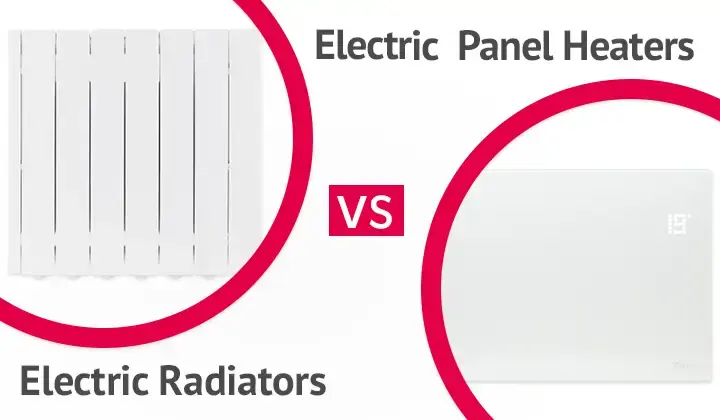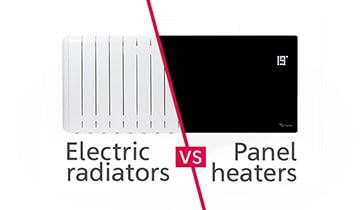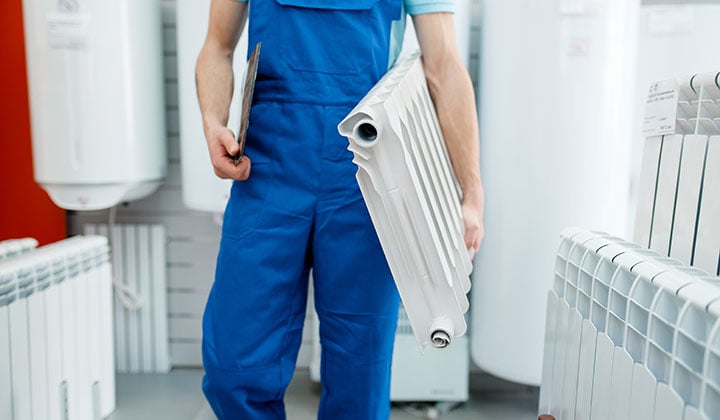5 min read
What’s the difference between electric radiators and panel heaters?
In this blog we run through the difference between electric radiators and panel heaters. If you are thinking about giving your home heating a bit of...

If you’re in the process of looking into installing electric radiators or panel heaters for your next project, this article could be just the thing you need to help you make the final decision on which one you choose.
We’ll cover:
The read time for this article is roughly 5 minutes. Ready? Let’s begin…
Electric radiators
Electric radiators work in a very similar way to central hating radiators but don’t rely on a network of pipes to deliver the heat. The majority of electric radiators are either filled with a thermal fluid such as oil or a dry element like a ceramic core which stores the heat. Electric radiators such as our Oil Filled Radiator, heat rooms by using a combination of convection (heating the air around them) and radiant heat. What’s radiant heat? Basically, heat by radiation warms people and objects directly. It’s like being warmed by the sun. If you step into the shade, you feel cooler as you are out of the direct warmth the sun provides. 
Electric panel heaters
Electric panel heaters (sometimes called convector heaters), warm rooms differently to electric radiators. An electric panel heater heats the air around it using convection. The warm air rises, cools and then sinks downwards before reheating again and circulating throughout the room. Examples of these types of heater include our popular Glass Panel Heater and our budget friendly Convector Panel Heater.
You’ll probably be able to notice if a room is heated using convection because the air in the room can often feel drier and ‘stuffy’ and you can also sometimes ‘smell the heat’. Sounds a little odd, doesn’t it? However, because the heating elements are exposed to air, it can burn the dust particles that are floating about in it which gives off a particular odour, hence ‘smell the heat’.

Fast to heat up
Electric radiators and panel heaters heat up faster than traditional central heating. As an example, oil filled radiators, on average, have a smaller thermal storage capacity which causes slower heat release at the start and prolonged heat release once they are switched off. A panel heater that doesn’t use any fluid, such as our Glass Panel Heater, heats a room quicker at the start and quickly stops releasing heat when it is switched off.
Installation
Electric radiators and panel heaters are simple to install and as there’s no pipework to connect to, it keeps installation cost to a minimum. The way they are installed will vary depending on the type you buy. Both electric radiators and panel heaters can be simply plugged into a standard 3 pin socket or hard-wired into the mains. If the model you have chosen is hard-wired to the mains, you’ll need to get a qualified electrician to make the connection for you. Connecting them directly to the mains can also make the installation look tidier too.
Maintenance
Both electric radiators and panel heaters require no maintenance. This is because they are not connected to a combustible fuel (gas) and don’t contain moving parts. The only thing you will need to do, is to dust them occasionally. All, they will need is dusting from time to time which means saving you money on any annual maintenance.
Controllability
Both electric radiators and panel heaters are available with inbuilt thermostats and smart technology which helps to reduce temperature overrun and maximise energy efficiency.
A top tip when looking at the technical specification of an electric radiator or panel heater, is to find information on the thermostat’s accuracy. You may see something like, ‘accurate to +0.3oC’ or ‘accurate to +0.8oC’. The more accurate the thermostat, the lower the number will be. Also, many models offer energy saving features such as ‘open window detection’ which is another way of helping to save money.
Heating zones
Both electric radiators and panel heaters can be easily controlled independently which allows you to create different heating zones throughout a property. For example, you may only want the heating on in a spare bedroom only when guests are staying. That means that you aren’t wasting energy and spending money on heating rooms that aren’t being used.
Efficiency
Even though electric heating is 100% efficient at point of use because all the power drawn is converted into heat, when it comes to efficiency of electric radiators vs panel heaters, one is more efficient that the other. But why?
Electric radiators generate about two thirds of their heat by convection (heating the surrounding air) and the other third by radiation (heating objects and people directly). This is why electric radiators such as the Oil Filled Radiator more energy efficient. Because even when turned off, the heat stored in the Oil will continue to radiate into the room. 
Use
Electric radiators are a much more economical choice as a primary heat source due to how they heat the room, as described above. Whereas electric panel heaters are better suited for heating rooms that do not require heating every day but require a quick burst of heat for spaces like spare bedrooms as they have faster heat-up times.
Cost per unit
On average, electric radiators are more expensive to buy than electric panel heaters and are cheaper to run. Why? Because electric panel heaters don’t store any heat and continually draw power as they heat the air. On the other hand, electric radiators only draw on heat when heating up the oil or ceramic brick inside them.
Durability
Electric panel heaters need to work harder to reach temperature and maintain warmth in rooms. This can increase the rate of wear and tear of the unit. They generally have a lower price point in the market too and the quality of components can often be lower than those found in electric radiators. 
When it comes to electric radiators or panel heaters, the British Thermal Unit (BTU) is a common measure of the heat a unit with emit into the room. If the BTU is too low, the space will not reach the desired temperature. If it is too high, the space could overheat quickly.
For calculating the BTU you will need to measure the length, width and height of the room and take into account windows and patio doors.
If you know the output (watts) of the radiator, simply multiply that by 3.41 to get the BTU/hr and if you have the BTU, you can divide it by 3.41 to get the watts or output you need.
For example, if the output of the electric radiator is 1000W then the BTU/hr would be 3,410:
1000(W) x 3.41 = 3,410 (BTU/hr)

Oil Filled Radiator
The Oil Filled Radiator is a great addition to any room where installing electric underfloor heating is not possible or if you’re looking for the ideal replacement for storage heaters.
|
SKU |
Max Area (m2) (High / Low Insulation) |
Size (mm) |
Output (W) |
BTU (BTU/hr) |
|
TSR-0500-A |
5.0 / 3.0 |
590 x 355 x 95 |
500 |
1,705 |
|
TSR-0800-A |
8.0 / 4.8 |
590 x 505 x 95 |
800 |
2,728 |
|
TSR-1000-A |
10.0 / 6.0 |
590 x 595 x 95 |
1000 |
3,410 |
|
TSR-1300-A |
13.0 / 7.8 |
590 x 745 x 95 |
1300 |
4,433 |
|
TSR-1500-A |
15.0 / 9.0 |
590 x 835 x 95 |
1500 |
5,115 |
|
TSR-2000-A |
20.0 / 12.0 |
590 x 1075 x 95 |
2000 |
6,820 |
Glass Panel Heater
The Glass Panel Heater comes with all the functionality needed to make heating control easy and efficient. Control it from a smartphone, a remote control or directly on the intuitive display.
|
SKU |
Max Area (m2) (High / Low Insulation) |
Size (mm) |
Output (W) |
BTU (BTU/hr) |
|
TSGFR-1500-W |
13.0 / 9.0 |
675 x 450 x 105 |
750 - 1500 |
2,558 – 5,115 |
|
TSGFR-2000-W |
18.0 / 12.0 |
835 x 450 x 105 |
1000 - 2000 |
3,410 – 6,820 |
|
TSGFR-1500-B |
13.0 / 9.0 |
675 x 450 x 105 |
750 - 1500 |
2,558 – 5,115 |
|
TSGFR-2000-B |
18.0 / 12.0 |
835 x 450 x 105 |
1000 - 2000 |
3,410 – 6,820 |
Convector Panel Heater
The EcoDesign Lot 20 compliant Convector Panel Heater is the cost-effective option if you want to spend less on a heater without compromising on the speed to heat rooms quickly.
|
SKU |
Max Area (m2) (High / Low Insulation) |
Size (mm) |
Output (W) |
BTU (BTU/hr) |
|
TSCR-0500 |
5.0 / 3.0 |
520 x 470 x 100 |
500 |
1,705 |
|
TSCR-1000 |
9.0 / 6.0 |
600 x 470 x 100 |
1000 |
3,410 |
|
TSCR-1500 |
13.0 / 9.0 |
720 x 470 x 100 |
1500 |
5,115 |
|
TSCR-2000 |
18.0 / 12.0 |
840 x 470 x 100 |
2000 |
6,820 |
We hope you’ve found this heating blog article useful. If you have any questions about electric radiators, panel heaters and/or the range of electric heating, please contact us via the website or give one of the team a call on 0800 019 5899.
Alternatively, you may find the following articles useful:
Are electric radiators better than traditional central heating system?
What’s the best electric radiator to buy?
What’s the difference between electric radiators and panel heaters?
The pros and cons of electric radiators

5 min read
In this blog we run through the difference between electric radiators and panel heaters. If you are thinking about giving your home heating a bit of...

6 min read
With a big shake-up well underway for how we heat homes, more homeowners are exploring different ways to heat their homes in a more cost-effective...

5 min read
If you are considering electric radiators as a heating option for your renovation or new build project, then you’re probably thinking about what is...